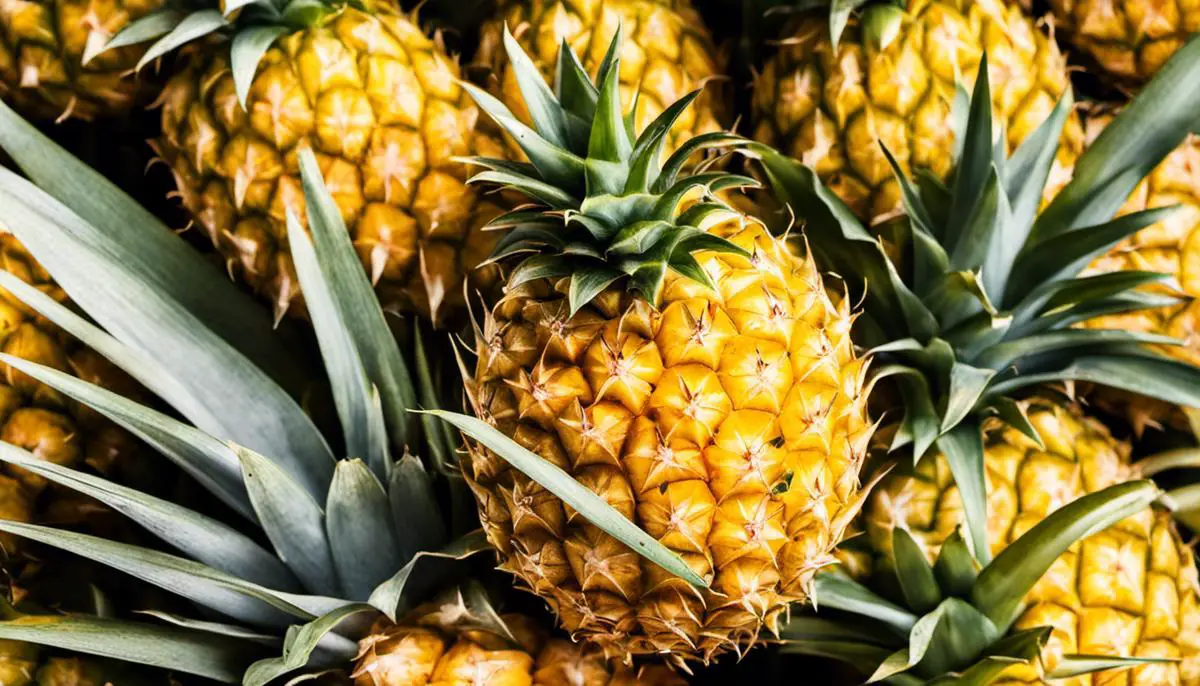
The mighty pineapple, a tropical fruit well-known not only for its distinct sweet-yet-tart taste but also for its numerous health benefits, is a surprising powerhouse of essential nutritional constituents. Engaging in a golden array of bioactive constituents like bromelain, dietary fibers, and various vitamins, pineapple is touted as the fruit that promotes optimum digestion. This fruit’s rich benefit to the digestive system stems from the fascinating science of these components and their interaction within the human body, significantly influencing the process of protein breakdown and overall digestion speed.
Bioactive Components in Pineapple
The Pineapple’s Bioactive Impact on Digestion: An In-Depth Examination
The fascinating realm of scientific inquiry extends its resilient tendrils into every nook and cranny of the world as we understand it – including our kitchen fruit bowls. Therein lies the humble pineapple, an exotic feast not just for taste buds, but also for the avid biochemist. How so? The answer lies within the topic of today’s discourse: the bioactive components in pineapple and their influence on digestion.
The pineapple, known scientifically as Ananas comosus, is a tropical plant with an edible fruit that has been valued in dietary regimes worldwide, largely due to its unique blend of enzymes, dietary fibers, vitamins, and other bioactive components. Chief among these bioactive components is bromelain – a complex mixture of protease enzymes instrumental in promoting optimal digestion.
Bromelain functions by breaking down proteins into simpler forms, a process scientifically known as proteolysis. This enzymatic effect aids in the transportation and absorption of dietary proteins within the human gastrointestinal tract, effectively pushing the gears of our digestive processes into smoother motion. Notably, bromelain’s radical protein breakdown is not solely linked to digestion as it also furthers extensive studies that explore its potential usage in mitigating symptoms of pancreatic insufficiency and intestinal inflammation.
Beyond the well-applauded bromelain, pineapples also contain a rich array of dietary fiber. Dietary fiber represents the indigestible portion of plant foods that absorbs water and eases the passage of food through the digestive system. Hence, it promotes intestinal regularity, adding another layer to the pineapple’s melodrama of digestive benefits.
A deeper dive under the microscope would reveal the role of specific vitamins in pineapples – vitamin C and vitamin B1 – in digestion. These vitamins indirectly support the digestive process: Vitamin C assists in the absorption of iron in the stomach, while Vitamin B1 (Thiamin) enhances the breakdown and release of energy from food.
Correctly understanding the pineapple’s status as more than just a sweet treat necessitates this recognition of its deeper bioactive components and their credible impact on digestion. As we continue to peel away at the layers of our understanding, the latent intricacies of the interplay between diet and digestion are illuminated, with each revelation being another testament to the far-reaching application of biochemistry in our lives. The evidence, whether harvested from dedicated lab work or inherent in the natural design of a pineapple, continues to serve as the backbone of this thrilling narrative of discovery. Strikingly so, as the acknowledgment of the potential biochemical benefits of what we ingest becomes more widespread, the future of nutrition and biochemistry research grows brighter, much like the vibrant hues of the pineapple standing staunch in our fruit bowls.
Indeed, the journey from the laboratories of biochemistry to our kitchen tables is not as far as one would presume. In understanding the bioactive influence of our dietary choices, we come one step closer to embracing an informed and healthier life. Consequently, as the world spins on the axis of knowledge, it is with sparkling eyes and anticipatory heartbeats that we observe, scrutinize, and learn from the wealth of wisdom written in the language of bioactive components – a language as rich and intriguing as the pineapple itself.

Role of Bromelain in Digestion
The Supremacy and Potential of Bromelain: Enzymatic Workhorse in the Pineapple
While the pineapple has oft been hailed for its lush, tropical flavor and rich content of vitamins C and B1, it now finds additional repute in the scientific arena, thanks to bromelain – a group of proteolytic enzymes found in the plant’s stem and fruit. Coupled with dietary fiber, these components synergistically contribute to the pineapple’s renowned digestive benefits.
Delving into the specifics, bromelain’s proteolytic action – its ability to break down proteins into simpler forms such as peptides and amino acids – facilitates numerous digestive processes. This enzymatic action on dietary proteins not only accelerates nutrient absorption but also aids in easing digestive discomfort linked to protein-rich diets.
Moreover, bromelain is of great interest to the scientific community due to its potential therapeutic benefits. This humble enzyme from the pineapple has demonstrated an ability to modulate pivotal biochemical pathways, resulting in significant anti-inflammatory and immunomodulatory effects. These attributes lend credence to the potential of bromelain in alleviating conditions of intestinal inflammation, elucidating why it has been used traditionally as a digestive aid in countries where pineapples are native.
Furthermore, the role of bromelain is not limited to enhancing protein digestion. Evidence from experimental research posits a potential Lipase-like activity, suggesting possible effects on fat digestion as well. Comprehending the underpinnings of these diverse actions and the ways in which bromelain could be manipulated for therapeutic benefits poses an exciting challenge to nutritional biochemists.
Molecular insights into the action of bromelain indicate its capacity to cleave large, complex molecules, an attribute that has been employed in recent research on drug delivery. Thus, our understanding of pineapple’s humble enzyme could potentially have far-reaching implications beyond nutrition and into the realm of pharmaceutical sciences.
These multifaceted roles of bromelain underscore the complexity of food biochemistry in human health. Equipped with such knowledge, consumers can now elevate their food discussions from the realm of the ordinary to the extraordinary. Beyond being just a fruit, the pineapple stands emblematic of the evolving scientific understanding of dietary choices. It is a delicious reminder of the potential for scientific advancements awaiting discovery in the realm of nutritional biochemistry.
Such progress underscores the necessity of staying abreast with the rapid advancements in biochemistry, where even the humble pineapple uncovers a scientific marvel in the form of bromelain. As researchers delve deeper into exploring its uncharted territories, we stand on the precipice of potentially game-changing revelations in the fields of nutrition, biochemistry, and therapeutics. One can only imagine where the path to understanding the unique attributes of common foods like pineapple will guide us. Science, after all, is only one bite away.

Comparative Analysis of Pineapple and other Fruits
Delineating the Benefits of Pineapple in Comparison with Other Fruits
A central focus of nutrition science has been to elucidate the relative benefits of various fruits on human health. Pineapple’s impressive arsenal of bioactive components projects this tropical fruit to the forefront of research investigations, placing it under indisputable scientific scrutiny in an attempt to understand how it may contribute to our digestive health, as compared to other fruits.
Pineapple’s unique bioactive component, bromelain, has been found to facilitate and enhance the process of digestion, thus distinguishing it from many other fruits. The absence of this proteolytic enzyme in most other fruits may underscore pineapple’s highlighted role in digestive health. On the other hand, fruits like papaya contain papain, another proteolytic enzyme, though studies indicate that bromelain’s range of influence may surpass that of papain due to its molecular structure and modus operandi.
To appreciate the comparative benefit of pineapple on digestion, one must observe the intricate context of human dietary habits. In modern eating patterns where a high intake of protein-rich meals is common, bromelain’s proteolytic abilities could alleviate strain on the digestive system, offering a balancing effect that may not be as significant with consumption of other fruits, given their lower enzyme content.
Among other fruits, apples and bananas are well-known for their beneficial implications on digestion, primarily attributed to their high fiber content. However, pineapple’s considerable fiber content, coupled with the proteolytic function of bromelain, provides a dual-advantage, aiding digestion on two distinct, yet integral levels – enzymatically and mechanically.
Lemons, oranges, and strawberries are celebrated for their high vitamin C content that assists in iron absorption, crucial for a well-functioning digestive system. Yet again, pineapple matches up, equally rich in vitamin C while adding the digestive benefits unique to its constitution.
In conclusion, while fruits each offer their own unique health benefits, the combination of bioactive components in pineapples sets them apart. It appears that pineapple, with its prized bromelain and valuable array of other nutrients, provides a comprehensive arsenal for promoting healthy digestion, thereby corroborating its elevated status in the realm of nutrition science and dietary preference. However, the comparative assessment of fruit benefits underscores the importance of integrating a variety of fruits in the diet to fully optimize the range of health benefits they collectively offer. Insights into the specific value of each fruit further enrich the breadth of nutritional wisdom and harness the power of informed dietary choices for the pursuit of optimal digestive health.

Potential Risks and Limitations
Moving beyond these benefits and into the realm of potential risks and limitations, it cannot be ignored that, like any substance, pineapple and its constituent bromelain may bring about unintended effects if consumed in copious amounts or in certain conditions. These adverse events, while seldom, should merit serious consideration to ensure safety and efficacy in exploiting pineapple’s digestive benefits.
Although pineapple is a natural source of bromelain, and thus perceived as benign, it is pivotal to remember the adage, “the dose makes the poison”. This implies that any substance, when consumed in excessively high concentration, may have toxic effects. Bromelain, due to its proteolytic prowess, can theoretically cause gastrointestinal discomfort or damage if ingested in overly high quantities, as this may promote excessive protein degradation in the stomach.
In a similar vein, people with pre-existing gastric ulcers or those prone to developing them may need to exert caution when consuming pineapple. Bromelain may potentially exacerbate the erosion of the gastric mucosal lining, given its protein-breaking capabilities. However, this is purely theoretical, and extensive research is further needed to determine the potential exacerbatory impact, practical bromelain thresholds, and frequency of occurrence in this context.
Individuals with allergy to pineapple, including oral allergy syndrome linked to bromelain, could also face complications. Itching, hives, or a more severe anaphylactic reaction are potential issues for those sensitive to bromelain or other pineapple constituents. Thus, people with known allergies or intolerances should avoid pineapple consumption unless given the go-ahead by their healthcare provider.
Furthermore, there is a latency in publishing a proper consensus on the appropriate bromelain dosage for maximum digestive benefits. Unregulated supplements have been a cause of concern, with variants in bromelain content across different products making it challenging to quantify an optimal daily intake. Coupled with the lack of extensive human clinical studies on bromelain safety and dosage, it can be arduous for individuals to navigate accurate supplement usage.
Lastly, interactions between bromelain and co-administered medications should not be overlooked. Bromelain is known to enhance absorption of certain drugs like antibiotics, increasing their bioavailability at the target site. While this is potentially beneficial in targeted drug delivery, unexpected increases in drug concentration may lead to unwanted side effects and toxicity. Hence, individuals on medication should seek advice from their healthcare provider before initiating bromelain consumption.
While not being a call to disavow the consumption of pineapple, these considerations reflect the quintessence of undertaking a holistic approach to nutrition: a comprehensive understanding that leads to safe, informed, and health-optimized dietary practices.

The impressive health perks associated with pineapples undoubtedly underscore its importance to digestive health. However, as with all things, a balanced approach is recommended. Essential to realize is that despite pineapples’ relative superiority in its enzymatic capabilities compared to other fruits, potential risks invite caution. These risks include but are not limited to allergies, exacerbation of specific medical conditions, and bromelain overconsumption. Consequently, the key lies in the informed, judicious consumption of pineapple. Savoring this tropical delight, while appreciating its scientifically proven digestive benefits, we enable healthier, more balanced lives, echoing the ancient adage – ‘Let thy food be thy medicine.’



